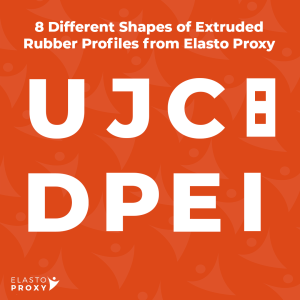Learn how to select the right rubber compounds for your seals, gaskets, and insulation.
Clyde Sharpe
General Manager at Elasto Proxy
Are you a technical buyer or a product designer? Have you ever heard the saying, “Be careful what you ask for because you just might get it”? If you need seals, gaskets, or insulation, it’s important to ask for more than just “black rubber”. If a supplier provides what you think that you need on the basis of color alone, your rubber parts may not support your product designs.
Yes, the color of a compound can be important. For example, if the color of a rubber gasket needs to match that of a medical assist device, you’ll want to work with a custom fabricator who can source materials from an extruder that uses pantone color matching. But even in this example, the rubber’s color probably isn’t the only consideration. Does the elastomer need to be soft and antimicrobial, too?
Industry and Application
Getting the seals, gaskets, and insulation that you really need involves answering a series of questions. You may think that all you want is “black rubber”, but a custom fabricator who takes the time to listen will analyze all of your requirements. Here at Elasto Proxy, our solutions providers understand that even if you do ask for “black rubber”, there’s probably more to your application. By asking you questions and carefully listening to your answers, we’ll help you to select the right rubber.
For starters, the industry that you serve is important. If you need a door seal for a dump truck, we’ll ask about exposure to cold temperatures and off-road conditions. If you need seat molding for buses or rail cars, we’ll ask if fireproof rubber is what you’re looking for. In the case of an oven seal, our solutions providers will find out if there’s exposure to direct flame. In the case of a hatch seal, we’ll want to know if your application involves contact with chemicals such as gasoline or diesel fuel.
Material Requirements and Compound Ratings
Industry and application are important, but there’s usually more to the story of what you need. What are your other material requirements? Do you need rubber parts that are molded or extruded? Since there are different ways to define an elastomer’s hardness, do you need a rubber seal with a specific Shore A durometer? What about ASTM call-outs? There are over 30 different categories and hundreds of individual ASTM designations, each with an alphanumeric code.
Speaking of standards, do you need to meet regulatory requirements or industry specifications? For example, buyers in the mass transit and rail industries may need to source rubber parts that meet flame, smoke, and toxicity (FST) standards such as SMP 800-C. In both the food and medical equipment industries, there are FDA standards for rubber articles. EMI / RFI shielding for military electronics might need to meet MIL-DTL-83528C requirements for elastomeric shielding gaskets
Quality Control
Fit and finish are important, too. What are your part’s surface finish requirements? The RMA Handbook from the Rubber Manufacturers Association (RMA) contains tolerance tables for molded and extruded rubber, and for both spliced lengths and cut lengths. Does your seal, gasket, or insulation need to meet the requirements of a specific RMA Tolerance Class? Part tolerances may vary depending upon the compound that you select.
“Be careful what you ask for because you just might get it” shouldn’t be a cause for concern when it’s time to select compounds for seals, gaskets, and insulation. Ask Elasto Proxy for what you need, and we’ll make sure that what we provide is what your application really requires. Contact us for more information, and watch this short video to learn more about compound selection.








